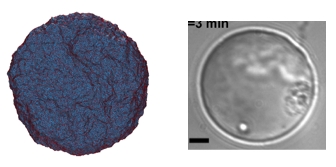Statistical Mechanics of Pressurized Shells�
 Computer simulation of an extremely thin spherical shell at high temperature. Strong thermal fluctuations give the shell a corrugated appearance. These same fluctuations also modify the elastic properties of the shell.
Experimental image of a "polymersome", a spherical polymer vesicle about 50 µm in diameter and about 10 nm thick, being crushed under osmotic pressure. Thermal fluctuations make such thin shells weaker at high temperatures.
Computer simulation of an extremely thin spherical shell at high temperature. Strong thermal fluctuations give the shell a corrugated appearance. These same fluctuations also modify the elastic properties of the shell.
Experimental image of a "polymersome", a spherical polymer vesicle about 50 µm in diameter and about 10 nm thick, being crushed under osmotic pressure. Thermal fluctuations make such thin shells weaker at high temperatures.
New experimental techniques have enabled the fabrication of extremely thin shells and vesicles, with thicknesses down to a few nanometers and diameters up to tens of microns. At such small length scales, thermal fluctuations strongly modify the elastic behavior of the shells. Classical shell theory, which successfully predicts the mechanical response of everyday shell structures such as ping-pong balls, must be modified to correctly describe the behavior of such thin shells. New theory and computer simulations calculate thermal corrections to the predictions of classical shell theory, and agree well with experimental measurements. These corrections have important implications for understanding the mechanical properties of microscale spheres which may be used for chemical and biomedical applications such as drug delivery.
David A. Weitz (Physics & Applied Physics)
Cynthia M. Friend (SEAS)
David R. Nelson (Physics)
Harvard MRSEC (DMR-1420570)
